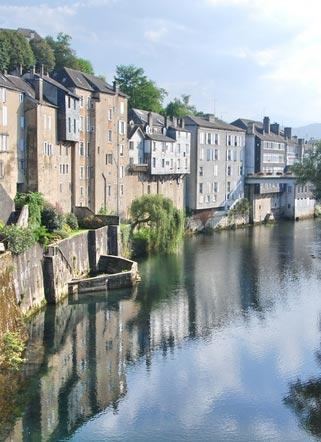Country France Intercommunality Piémont Oloronais Area 68.31 km² | Population (2012) 10,678 Local time Friday 7:39 AM | |
 | ||
Weather 4°C, Wind S at 6 km/h, 79% Humidity Points of interest Oloron Cathedral, Public Garden, Église Sainte‑Croix d'Oloron, Villa du Pays d'art et d'histoi | ||
Oloron sainte marie
Oloron-Sainte-Marie ([ɔlɔʁɔ̃ sɛ̃t maʁi]) is a commune in the Pyrénées-Atlantiques department in the region of Béarn in south-western France.
Contents
- Oloron sainte marie
- Map of 64400 Oloron Sainte Marie France
- History
- Location
- Climate
- Economy
- Language
- Architectural and historical landmarks
- Cultural life
- Gastronomy
- Notable people
- References
Map of 64400 Oloron-Sainte-Marie, France
History
The town was founded by the Romans in the 1st century, then known as Illoronensium. Situated on the Roman way between the important towns of Dax and Saragossa, its position was strategic. Today known as Saint-Great, Gratus of Oloron became in 506 the first known archbishop of the Ancient Diocese of Oloron then known as "Iluro".
The history of the town during the Migration Period is little known. In 1080, the viscount Centule V, Viscount of Béarn built the new city of "Oloron" (medieval version of the Roman name Iluro) on the opposite side of the river from the diocese center. Centulle V restored the Roman walls and founded the strong city of Oloron that was to be used as a base to retake the Aragon held by the Maures. The Oloron Cathedral was built at the beginning of the 12th century. The viscountal town of Oloron and the episcopal town of Sainte-Marie were then rival, but Oloron strived on its textile industry and commerce with neighbouring Spain. Sainte-Marie became economically dependent upon Oloron.
The 18th century was the beginning of revival for Sainte-Marie as the end of French Wars of Religion allowed for restorations and new religious constructions in the town : cathedral, seminary, church Saint-Pierre. Morever, the continued boom of commerce with Spain accelerated the construction of better communication and transportation ways to Oloron and Sainte-Marie.
With the French Revolution Oloron lost its diocese to Bayonne but gained administrative importance by becoming one of the sous-préfectures of the new Republic. In the 1858, the regent Impress Eugénie imposed the reunification of the towns of Oloron and Sainte-Marie.
Location
Situated at the feet of the Pyrénées, 50 km from the Spanish border and 100 km from the Atlantic ocean, Oloron-Sainte-Marie is at the confluence of two gaves (mountain rivers), the Gave d'Aspe and the Gave d'Ossau that merge to form the gave d'Oloron. Capital of the Haut-Béarn, Oloron-Sainte-Marie is also at the point of origin of the three Haut-Béarn valleys : the Aspe valley, the Ossau Valley and the Barétous valley.
Neighboring communes: Esquiule, Moumour, Ledeuix, Estos, Cardesse, Monein, Goès, Précilhon, Escout, Herrère, Ogeu-les-Bains, Buziet, Arudy, Escot, Asasp-Arros, Lurbe-Saint-Christau, Eysus, Gurmençon, Bidos, Agnos, Ance and Féas.
Climate
The town has an oceanic climate, with mild and humid winters and cool or moderately warm summers. Rain is quite abundant (above 900 mm per year) and is mostly concentrated during cold season.
Economy
The Oloron economy is dominated by two well known manufacturing businesses:
* Lindt & Sprüngli have a chocolate factory in Oloron.* Messier-Bugatti-Dowty have a plant in the adjacent commune of Bidos which manufactures landing gear for aircraft.Oloron is also famous, among hat enthusiasts, as the capital of the basque beret, although the beret business has fallen victim to the widespread collapse of the European textile business as well as changing fashions. Today only one beret business survives in Oloron. This is the Béatex company which employs approximately 80 people.
The area also benefits from an active agriculture sector, involving animal rearing and general agriculture as well as maize production. It is also part of the AOC defined districts entitled to produce the ewes' cheese, Ossau-Iraty.
Language
The local vernacular language is the Béarnese dialect, a dialect of Gascon language. One of the eight primary schools of Oloron is a Calandreta, a French/Bearnese bilingual school.
Architectural and historical landmarks
The town received the label French Towns and Lands of Art and History in November 2006.
Oloron's architectural and historical landmarks :
Cultural life
Oloron is home to a number of festivals :
Oloron-Sainte-Marie has a theatre and concert venue (espace Pierre Jéliote).
Gastronomy
The town is renowned for its hearty vegetables, beans and meat soup, the garbure, for the Ossau-Iraty cheese, and for a delicacy invented by a local baker in 1925, the pastry "le Russe".
Notable people
Oloron-Sainte-Marie was the birthplace of:
